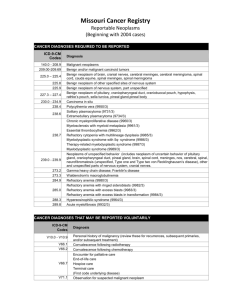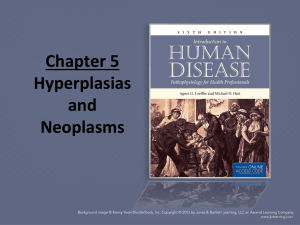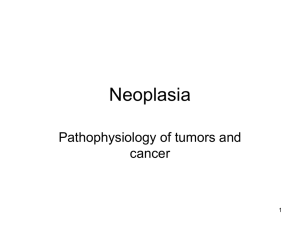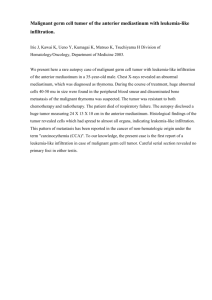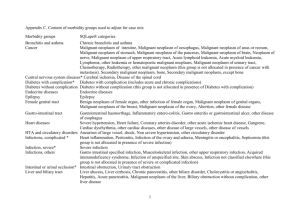Vocabulary list
advertisement
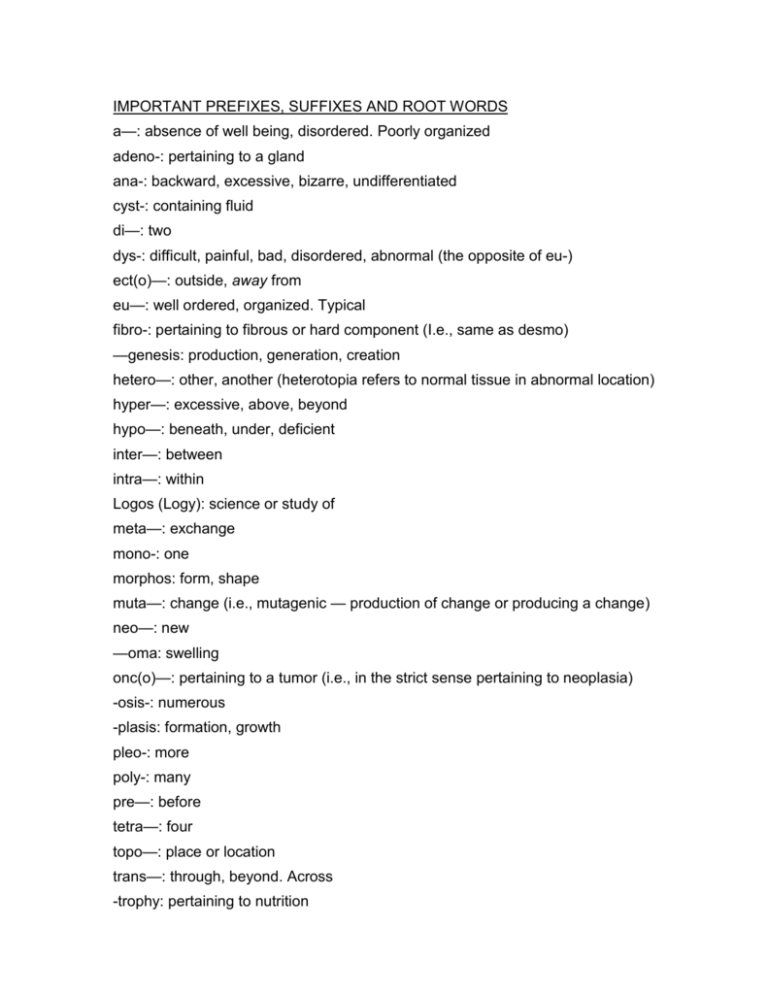
IMPORTANT PREFIXES, SUFFIXES AND ROOT WORDS a—: absence of well being, disordered. Poorly organized adeno-: pertaining to a gland ana-: backward, excessive, bizarre, undifferentiated cyst-: containing fluid di—: two dys-: difficult, painful, bad, disordered, abnormal (the opposite of eu-) ect(o)—: outside, away from eu—: well ordered, organized. Typical fibro-: pertaining to fibrous or hard component (I.e., same as desmo) —genesis: production, generation, creation hetero—: other, another (heterotopia refers to normal tissue in abnormal location) hyper—: excessive, above, beyond hypo—: beneath, under, deficient inter—: between intra—: within Logos (Logy): science or study of meta—: exchange mono-: one morphos: form, shape muta—: change (i.e., mutagenic — production of change or producing a change) neo—: new —oma: swelling onc(o)—: pertaining to a tumor (i.e., in the strict sense pertaining to neoplasia) -osis-: numerous -plasis: formation, growth pleo-: more poly-: many pre—: before tetra—: four topo—: place or location trans—: through, beyond. Across -trophy: pertaining to nutrition DEFINITIONS ADENOMA: neoplasms of epithelial tissue in which the tumor cells form benign glands ANAPLASIA: Loss of structural differentiation or reversion to a more primitive type. ANEUPLOID: Abnormal number of chromosomes. not an exact multiple of the haploid number. ATROPHY: Decrease in cell size due to loss of cell substance and decrease in organ size. ATYPIA: State of not being typical (an adjective used to describe cell.). BENIGN: Non-malignant. CANCER: A general term used to indicate any of various types of malignant neoplasms. CARCINOGENIC: Causing cancer. CARCINOMA: Malignant neoplasm of epithelial origin. DISSEMINATION: Distant spread; usually refers to a neoplasm. DYSPLASIA: Irregular, atypical deranged cellular development with change in cell size, shape and organization. May be reversible, may be pre-malignant. ECTOPIC: (Out of place) an organ or tissue which is not in its proper position. i.e. ectopic pregnancy. EPIDERMOID: Squamous epithilium EPITHILIUM: A thin layer of tissue that covers organs, glands, and other structures within the body. GRADE: Degree of dlfferentiation. Usually a subjective microscopic evaluation performed by a pathologist GROWTH: Tumor, neoplasm; increase in size of a living being or any of its parts. HETEROTOPIC: The presence of a tissue in an area in which it is normally absent. HYPERPLASIA: Increase in the number of cells in an organ or tissue (usually with resultant increase in organ size). HYPERTROPHY: Increase in cell size which may then result in increased organ size. IN SITU: Location in the site where it normally resides or is found. IN VITRO: In the laboratory (outside the body); the opposite of in vivo (in the body). IN VIVO: In the body; the opposite of in vitro (outside the body or in the laboratory). INVASION: Spread of a carcinoma beyond the basement membrane into connective tissue or spread of a sarcoma into adjacent normal connective tissue (usually this refers to local spread). MALFORMATION: Deformity, which may be congenital or acquired. MALIGNANT: In the case of a neoplasm, having the property of uncontrollable growth and dissemination. MALIGNANT TRANSFORMATION: Conversion of non-malignant or premalignant lesion to cancer. MASS: Lesion taking up space. MESENCHYMAL: Embryonic tissue (one of three types), muscle and fat are derived from this. METAPLASIA: Reversible change in which one mature cell type is replaced by another. METASTASIS: In cancer, the appearance of secondary tumors in parts of the body remote from the primary tumor. MONOMORPHIC: One uniform type. MUTAGENIC: Causing mutations. NEOPLASIA: Abnormal mass of tissue, the growth of which exceeds and is uncoordinated with that of normal tissue and persists after cessation of the inciting stimuli, usually from one cell of origin (monoclonal). OCCULT: Hidden, concealed, not seen grossly but present microscopically. ONCOGENIC: Causing, inducing or being suitable for the formation and development of a neoplasm. ONCOLOGY: The study or science dealing with the physical, chemical, and biological features of neoplasms. PAPILLOMA: A circumscribed overgrowth or hypertrophy of the papillae of a cutaneous surface. PAPILLOMATOSIS: Multiple papillomas. PLEOMORPHIC: Occurring in more than one morphological form; multiform; variation in size and shape. POLYMORPHIC: Pleomorphic. POLYP: Any mass of tissue that bulges or projects from the normal surface level. POLYPLOID: Three or higher multiples of the haploid number chromosomes. POLYPOSIS: Multiple polyps. PRE-CANCEROUS: Potential to become cancerous. PRE-MALIGNANT: Potential to become malignant. PRIMARY: Origin of a neoplasm. PROGNOSIS: The foretelling of the probable course of a disease; a forecast of the outcome of a disease. SARCOMA: Malignant neoplasm of mesenchymal origin. SECONDARY: Additional neoplasms growing at sites away from the primary tumor (METASTATIC) SQUAMOUS: A type of epithelium. Skin is an example. STAGE: Extent of spread (each type of cancer is staged differently). TETRAPLOID: Four times the haploid number





